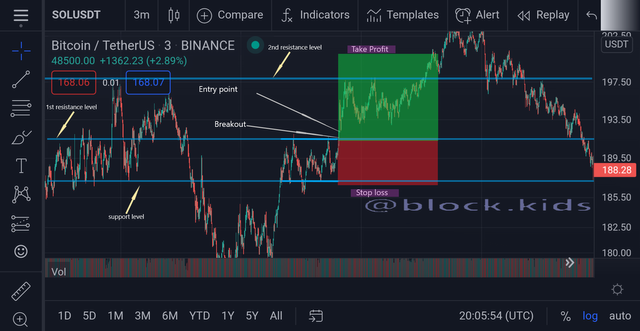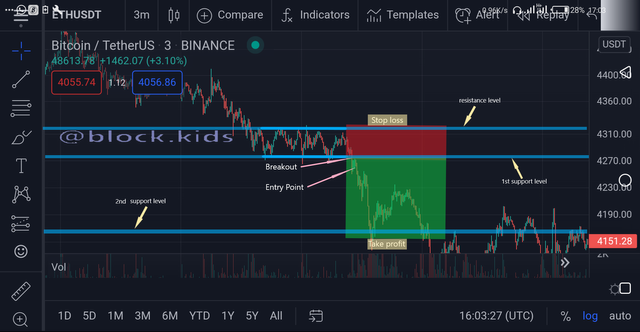Risk Management and Trade Criteria - Crypto Academy / S5W7- Homework Post for @reminiscence01

Hello everyone!
This is the 7th week in cryptoacademy-Season 5. This season has helped the beginners level within the cryptoacademy explore various aspects of Trading cryptocurrencies.
Trading cryptocurrencies is a very risky venture, therefore irrespective of the trading strategy used by the trader there is still a great level of risk involved.
Professor reminiscence01 through his lecture titled ' Risk Management and Trade Criteria' enlightened the academy on how to better manage these risks involved in trading cryptocurrencies.
My view of the above-mentioned topic is shared through the completion of the tasks embedded in Professor reminiscence01's lecture post.

Task 1
What do you understand by "Risk Management"? What is the importance of risk management in Crypto Trading?.

What is Risk Management
Risk Management in crypto trading refers to a process whereby the trader determines the acceptable level of risk in a trading environment and then tries to minimize personal trading risk levels for a series of trades below the acceptable risk level by employing special risk assessment and mitigation techniques like technical and psychological techniques.
In simpler terms risk in trading refers to losses suffered during trade sessions and keeping in mind that making a loss is inevitable as far as trading cryptocurrencies is concerned, risk management deals with the whole process which aids the trader to reduce the rate and amount in which losses are incurred during trading sessions.
Why is Risk Management So Important?
The goal of every trader before entering any trading position is to make a profit off that trade set up, however, if the trader does not properly manage the risk involved in that trading session it may lead to a loss in the long run even if a profit is made of the initial trade set up.
In essence, the success of every trader is hinged on the risk management capability of that trader. Proper risk management in trading will help keep a trader's profit to loss ratio in a safe zone constantly.
In addition, proper risk Management helps the trader prevent certain unwanted situations like;
- Trading based on emotional impulses: Incurring a loss can be emotionally hurtful and if the trader does not control their emotions by practicing proper risk management, the trader might end up entering a series of trade positions in a bid to recover losses but will rather exhaust their Trading capital by Incurring more losses.
- Loss of confidence in Trading strategies: A trader who disregards proper risk Management when trading is likely to believe that a generally accepted winning strategy doesn't work. This is due to the high rate of losses the trader will experience even if they adopted these wining strategies.
- Indecision when deciding entry and exit positions for a trade: A proper Risk Management technique will offer the trader a keen perspective on when and how a trader should both enter and exit a trade set-up. In essence, the trader's confidence when entering and exiting a trade is boosted.
Task 2
Explain the following Risk Management tools and give an illustrative example of each of them.
- 1% Rule.
- Risk-reward ratio.
- Stoploss and take profit.
1% Rule
The 1% rule is a risk management tool that protects traders from depleting their trading capital within a few rounds of trades
When trading, novice traders make the mistake of risking a large portion of their trading capital in hopes of making massive profits. This action is true evidence of poor risk management.
The 1% rule advises traders to risk a minimal portion (At least 1-3%) of their trading capital when entering a trading position. This rule does not just help the trader stem losses but also allows the trader to recover from losses without depleting their trading capital.
To better understand the 1% rule, here is an illustration of two scenarios;
- 1st scenario : A trader disregards the 1% rule.
- 2nd scenario: A trader applies the 1% rule.
1st Scenerio
If a trader has a $100 account and the trader risk 5% with 2 positions opened.
The trader will be risking a total of
5% of $100 × 2 = $10×2 = $20
Let's assume that the trader incurs 3 losses in a row,
i.e. $20 × 3 = $60,
Account balance = $100 - $60 = $40
From the illustration above, we can see that the trader has already lost over 50% of his trading capital and if the trader is emotionally pressured to try and recover his lost funds, it will only lead to poor decision making in subsequent Trading sessions. In the end, the trader will deplete his /her trading capital.
2nd Scenerio
If a trader has a $100 account and the trader applies the 1% rule and risks only 2% of the trading capital with 2 positions opened.
The trader will be risking a total of
2% of $100 × 2 = $2×2 = $4
Let's assume that the trader suffers 3 losses in a row,
i.e. $4 × 3 = $12
Account balance = $100 - $12 = $88
From the illustration above, the application of the 1% rule will help the trader save over 80% of the total trading capital even after suffering from 3 losses. This is a proper example of good risk management.
Risk-reward ratio
Trading cryptocurrencies means that you will suffer losses and also make profits, however, when the amount of losses suffered equates or exceeds the number of profits made the trader does not gain any reward.
The Risk-reward ratio is a Risk management tool that helps the trader cumulatively get rewarded for risking assets while trading.
This tool helps guide traders to choose appropriate positions for their stop loss and take profit during a trade setup.
'Stoploss' and ***' take profit' positions are automatic exit positions from a trade set-up.
Therefore, The risk-reward ratio can be referred to as a ratio of stop loss to take profit.
It is always advisable for a trader's 'take profit' to be greater than his 'stop loss', therefore, a minimum of 1:2 for a risk-reward ratio is recommended. A '1:2' risk-reward ratio means that the 'stop loss' position is half that of the 'take profit' from the entry point of the trade.
Here is a simple illustration of a 1:2 risk-reward ratio:
A trader enters a trade on the STM/USDT trading chart when the value of Steem is $10. The trader analyzes that the value of Steem will rise, Therefore with a 1:2 risk-reward ratio the trader sets his take profit at the value of $12 and his stop loss at the value of $9. Here the trader risks losing only $1 if the trade fails while the trader is rewarded $2 if the trade is successful.
The above illustration shows that the trader's capital will grow regardless of the few losses he will suffer in the long run.. Therefore, it is wise to avoid any trade setup that offers a 1:1 risk-reward ratio or less because that trade doesn't worth the risk.
Stop loss and Take-profit
As mentioned above, the stop loss and Take-profit positions are automatic exit points from a trade set-up. A trade can either close with a profit or a loss and setting a take profit position or stop loss position determines exactly how much profit or loss a trader is willing to gain or risk respectively.
For proper risk management, it is always advisable that sets his take profit to be at least twice that of his stop loss. In cases where the trader has absolute confidence in his/her prediction, take profit might even be as much as three times the stop loss.
There are several strategies used to set take profit and stop-loss position that helps the trader have an edge over the market. Some of these strategies include support and resistance levels, market structures, trend lines, channels, and moving average indicators.
An illustration of a proper setup of taking profit and stop-loss position is shown in the screenshot below.




Task 3
Open a demo account with $100 and place two demo trades on the following;(Original Screenshots on Crypto pair required).
a) Trend Reversal using Market Structure.
b) Trend Continuation using Market Structure.
The following are expected from the trade;
- Explain the trade criteria.
- Explain how much you are risking on the $100 account using the 1% rule.
- Calculate the risk-reward ratio for the trade to determine stop loss and take profit positions.
- Place your stop loss and take profit position using the exit criteria for market structure.


Conclusion

Practicing proper Risk Management is a vital path to becoming a successful trader when trading cryptocurrencies.
As Traders, we will not always make a profit when trading, sometimes we may suffer losses but with proper risk management we are emotionally and financially protected with the opportunity of bouncing back from these losses.
Some of these effective risk management tools include the 1%rule, placing 'stop loss' and 'take profit' positions, and the risk-reward ratio.
Learning about risk management is one of my highlights in Steemit's Cryptoacademy and I am glad to be part of this week's activities.

Hello @block.kids, I’m glad you participated in the 7th week Season 5 of the Beginner’s class at the Steemit Crypto Academy. Your grades in this task are as follows:
Observations:
Risk management is all about reducing exposure to risk when trading.
Recommendation / Feedback:
Thank you for submitting your homework task.